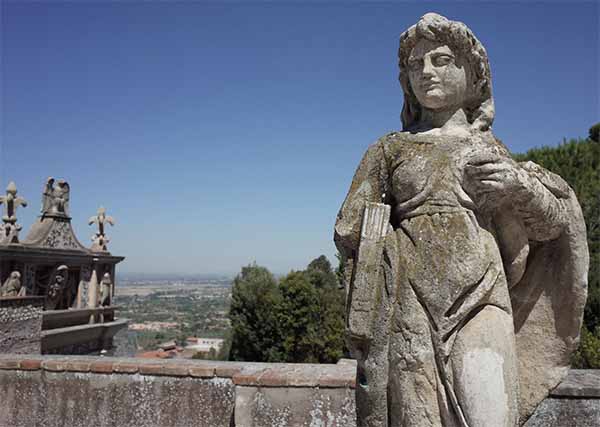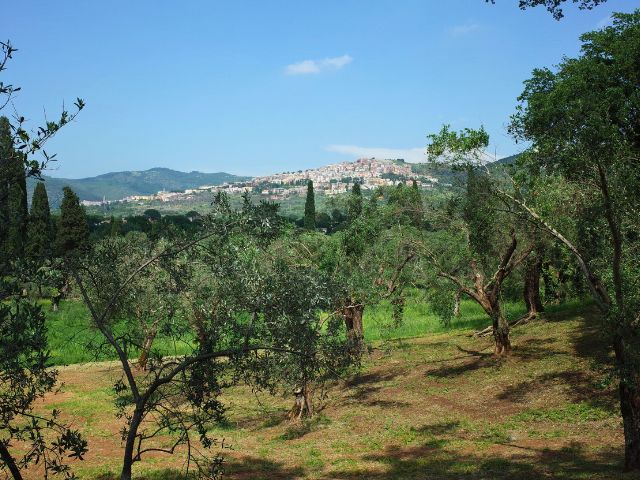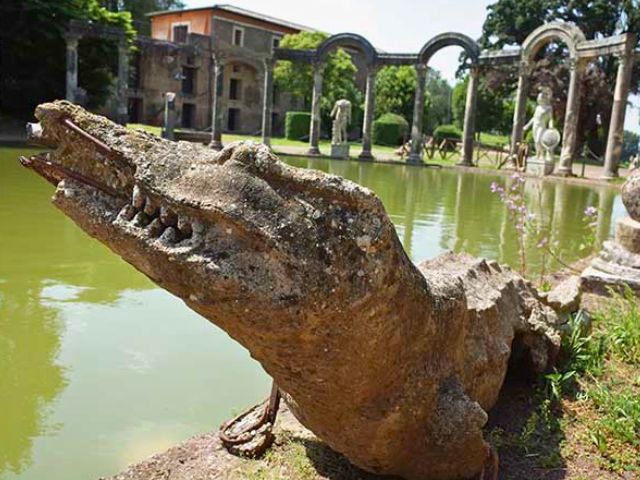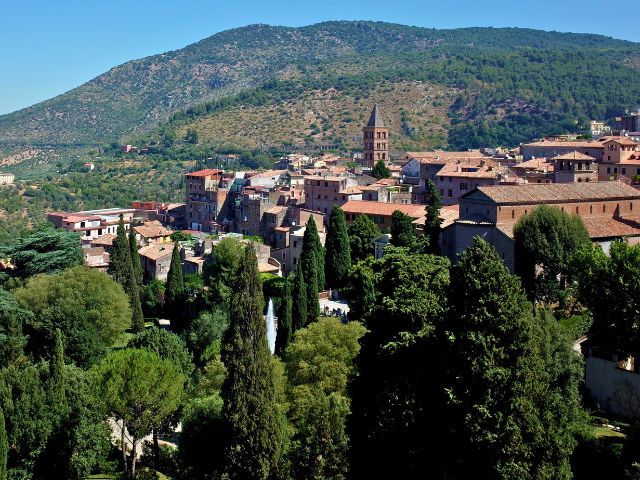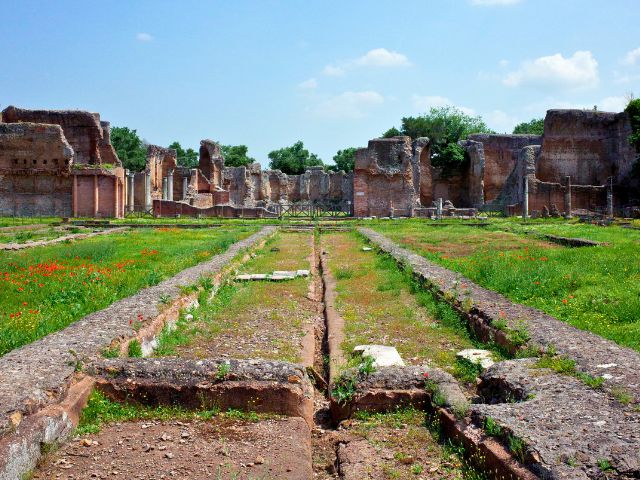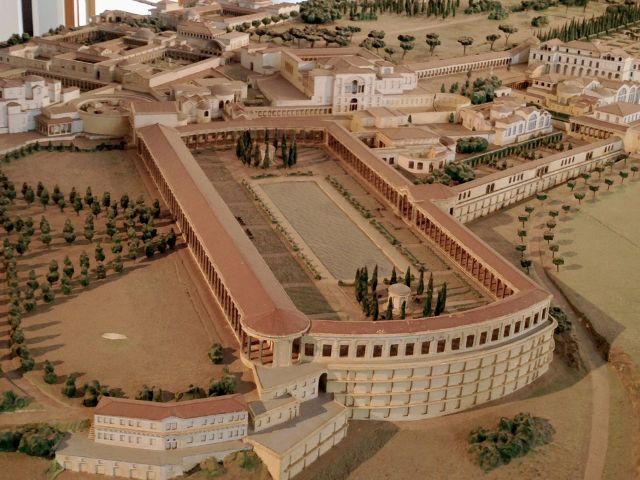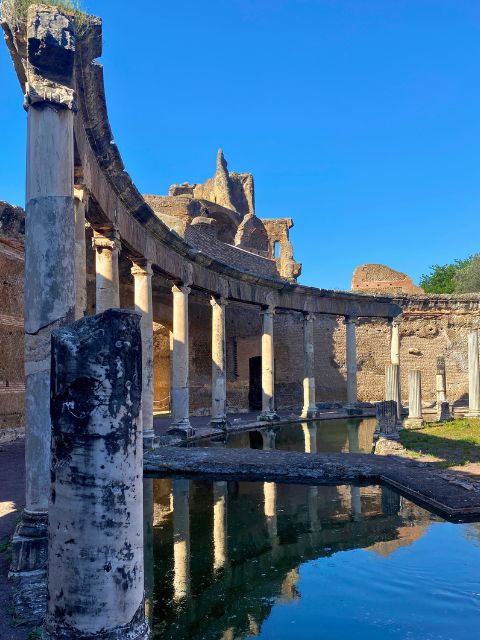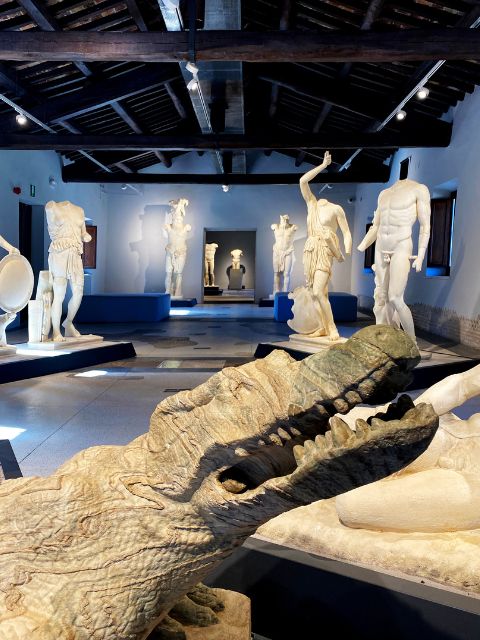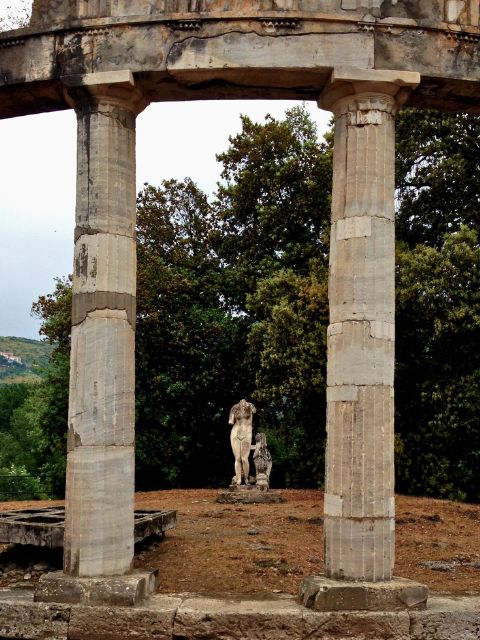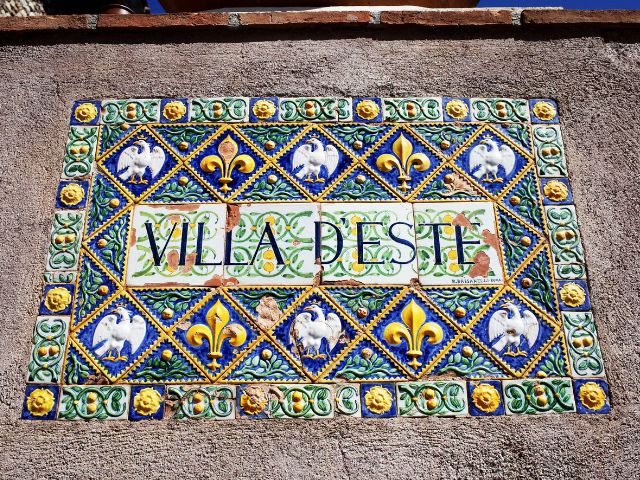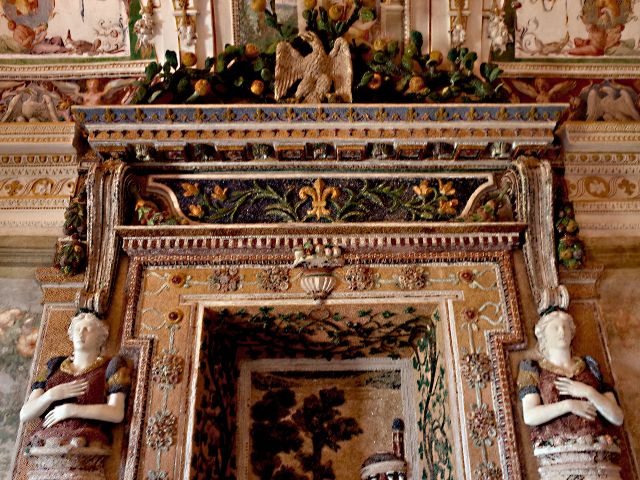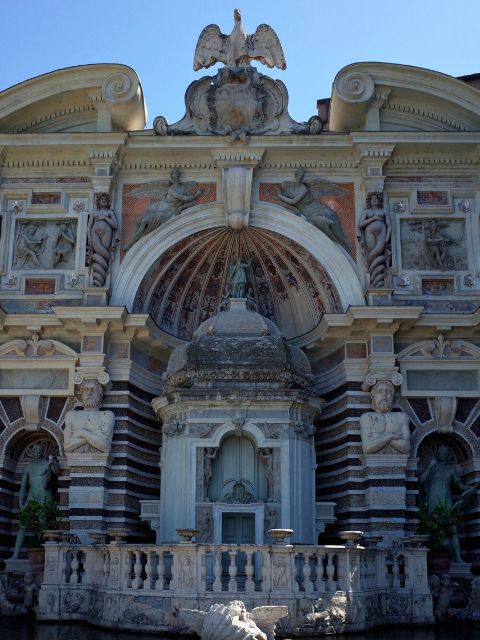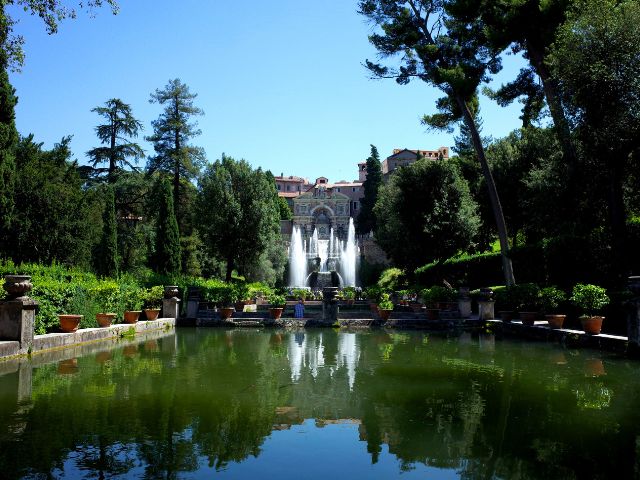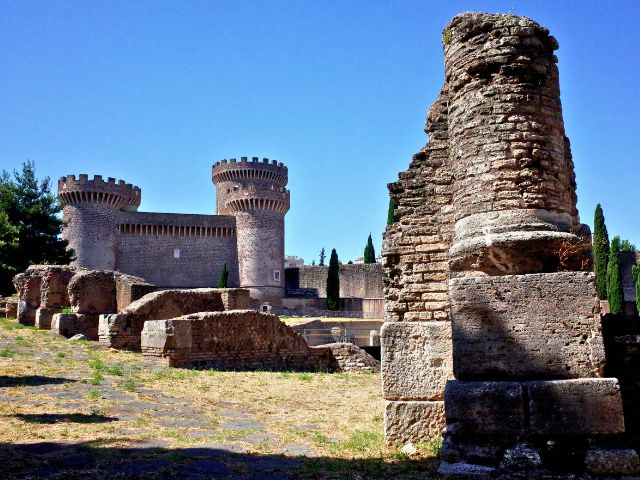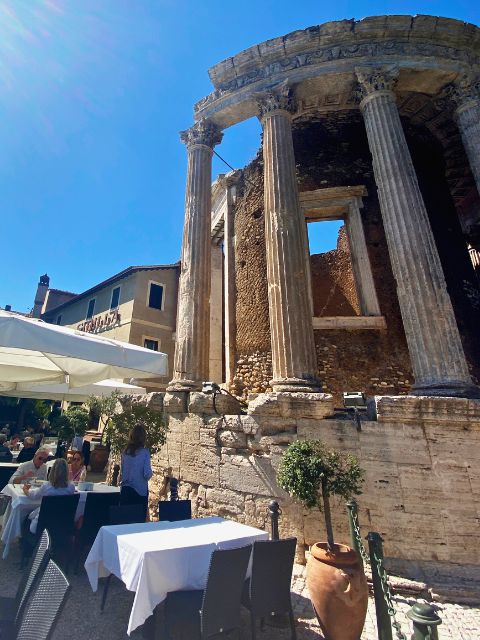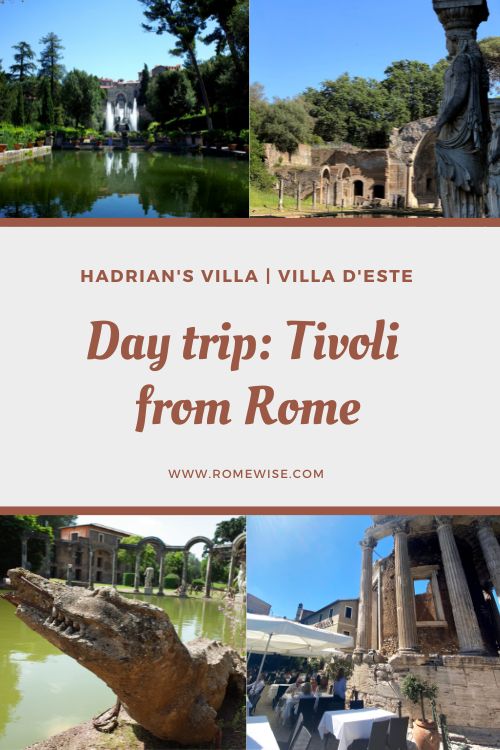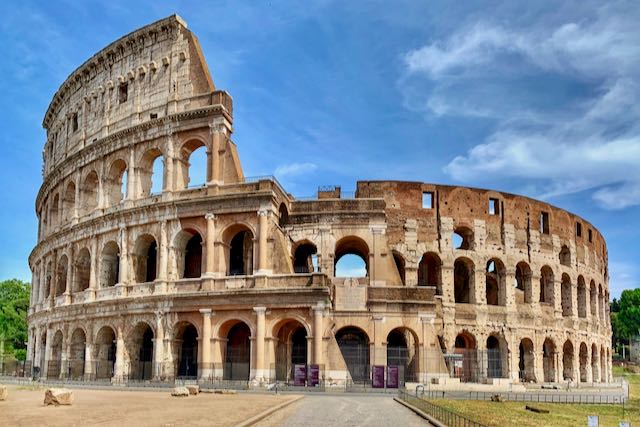- Sign up & get a FREE ebook Subscribe NOW!
- Romewise Home Page
- What to Do in Rome
- Romantic Things to Do in Rome
- Tivoli Day Trip
Tivoli Day Trip from Rome – Visit Hadrian’s Villa & Villa d’Este
I love visiting Tivoli as a day trip from Rome. Even just for lunch believe it or not!
Whether you're interested in ancient history, beautiful gardens, or if you're just looking to escape the crowds, there is something here for you.
Everything you need to know about taking a Tivoli day trip from Rome
Tivoli is a popular destination for tours and a great day trip from Rome.
I love the area, and have been visiting ever since my early trips to Rome over a decade ago.
The ancient Roman archeological site of Villa Adriana is my personal favorite place to visit, but the stunning fountains and gardens of Villa d'Este come a close second.
A day trip to Tivoli is a great way to take a break from Rome, and to see unique architecture and art from both Ancient Rome and from the Renaissance.
On this page, I’ll tell you how to get to Tivoli and Hadrian’s Villa from Rome, what to see and do, and some great places to eat.
On this page we'll be covering:
- Why visit Tivoli?
- Where is Tivoli in relation to Rome?
- How to get from Rome to Tivoli
- The best time to visit Tivoli
- Visiting Hadrian’s Villa (Villa Adriana) in Tivoli
- Visiting Villa d’Este in Tivoli
- Other things to see in Tivoli
- Where to eat and drink in Tivoli
Follow Elyssa in this YouTube video as she explores Hadrian's Villa and Villa d'Este on a fun day trip from Rome!
Why visit Tivoli?
Is Tivoli worth visiting?
Absolutely!
Tivoli is home to not one, but two UNESCO World Heritage sites, Hadrian’s Villa (Villa Adriana in Italian) and Villa d’Este.
It is possible to visit both villas in the same day, either by yourself or as part of a guided tour.
Tivoli sits on the side of a large hill, from which natural freshwater springs flow.
This creates a series of waterfalls which are visible from the historic center and the surrounding local area.
Throughout Tivoli you’ll find numerous Roman ruins, and on the outskirts there are remains of ancient aqueducts, along with several hiking and cycling routes.
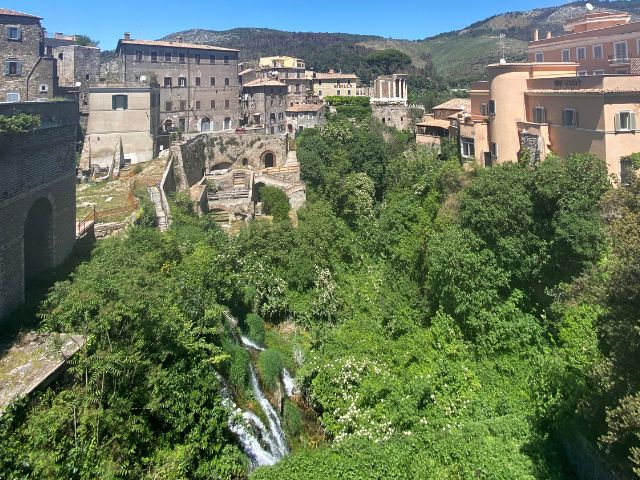 Tivoli's freshwater springs were no doubt a draw for the area's first settlers, and now make for an incredible sight!
Tivoli's freshwater springs were no doubt a draw for the area's first settlers, and now make for an incredible sight!Where to stay in Tivoli
If you want to spend a relaxing few days away from the bustle of Rome, Tivoli is a lovely place to stay while still exploring amazing sites.
If you have a car, staying outside the town is a great idea.
If you are using public transportation, I recommend staying close to the historic center, whether near the Villa D'Este or near the Temple of Vesta.
But Tivoli is pretty small and easy to walk around, so just pick someplace fairly central.
Where is Tivoli in relation to Rome?
Tivoli is located 27 km / 36 miles (as the crow flies) from the center of Rome.
Villa d'Este is in the center of the modern town, whereas Villa Adriana is located on the outskirts.
💎 Explore Villas Fit for Emperors & Cardinals 💎
Discover Rome's countryside treasures with this unique combination experience. From Emperor Hadrian’s Villa to the stunning Villa d'Este and Villa Gregoriana, experience lavish gardens and Roman grandeur.
How to get from Rome to Tivoli
Getting to Tivoli from Rome couldn’t be easier.
You have a couple of options for a self-guided day trip:
Public transportation
Train + Bus
The most direct route to the main sights of Tivoli from the center of Rome is to take the Metro Line B (blue line) to the Ponte Mammolo station, and then a bus.
At the Rome train station, make your way to a ticket booth to pick up tickets for the regional train to TIVOLI. You can pick up return tickets at this point although you can always get some more at Tivoli train station. Two return tickets to Tivoli from Rome will cost between 9 - 16 Euro.
When you step out of the Ponte Mammolo station, you will see a number of buses from a company called Cotral.
From here, you can take any of the buses marked as heading to Tivoli.
- One of the buses takes a more winding route, stopping around 300m / 1,000ft from the entrance to Villa Adriana before heading into Tivoli. This bus runs much less frequently.
- The other bus routes are more direct - if you are visiting Hadrian's Villa you will need to get off at the stop on via Tiburtina and walk around 2km / 1.2mi to reach the entrance.
Train from Rome to Tivoli
There are various trains that stop in Tivoli from the central Rome stations of Termini or Tiburtina - there are more trains leaving from Tiburtina than there are from Termini.
The journey to Tivoli will take about an hour, but once you get out into the country the scenery is beautiful.
And while the train is the fastest and most direct way to get from Rome to Tivoli, you should know that the Tivoli train station is located at the bottom of the hill.
To reach the sights, you will need to then take a local bus, or you can walk - it's around a 25 minute uphill walk.
When you reach Tivoli station, avoid the temptation to follow the road that leads down to the right. Instead walk a short distance down and cut through to a path on the left that will lead you down to a modern 3 span bridge that stretches across the river.
From this point you now have two choices:
1. Follow the signs to Villa D'Este
2. Get the bus to Villa Adriana / Hadrian's Villa.
Villa d'Este is about 4 km / 2.5 miles away from Hadrian's Villa.
Driving
To drive to Tivoli from the center of Rome takes between 45 minutes and an hour, depending on where you set off from.
If you're heading to Hadrian’s Villa there is plentiful and cheap parking on site.
You need to pay for parking at the ticket office when you buy your tickets to the archaeological park, or redeem your pre-booked tickets if you booked on line tickets.
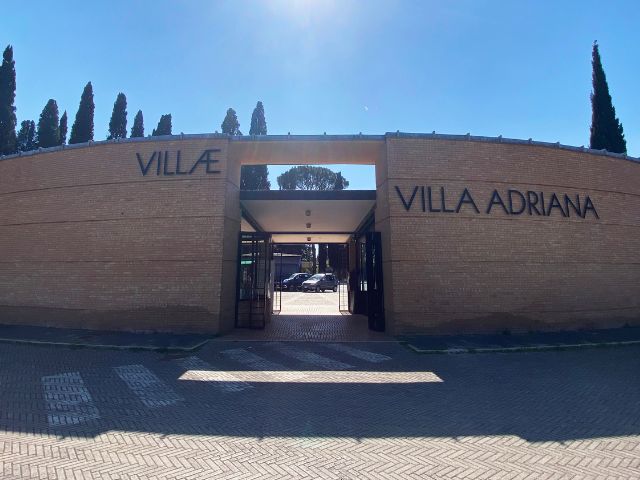 You can't miss the modern entrance to Hadrian's Villa on arrival, here you'll find bathrooms, the ticket office and a gift shop.
You can't miss the modern entrance to Hadrian's Villa on arrival, here you'll find bathrooms, the ticket office and a gift shop.Driving to Villa d’Este is a little more difficult as there is no official car park, but there are several options nearby.
You can park on one of the side streets nearby where you’ll need to pay at one of the machines along the sidewalks (pay close attention to the time frames and conditions) or in one of the official car parks listed below.
For the historic center of Tivoli in general if you’re wanting to see the waterfalls or other historical landmarks, I’d recommend parking in this carpark.
If you find that’s full (possible during the busier summer months), try one of these:
Join a guided tour
The other option for your Tivoli day trip is to book a private tour.
You can opt for half day guided tours which typically cover one of the area's main sites, or a joint experience that covers both Villa d’Este and Hadrian’s Villa, plus often other sites.
These type of tours have transfers to and from Rome included for a stress-free day trip from Rome.
If you're worried about navigating the public transport options or aren't comfortable driving yourself, I definitely feel that booking a tour is the best option.
Here are some of our recommended tours:
- Villa d'Este and Villa Adriana round trip from Rome with skip the line access and live guide at both sites
- Hadrian's Villa and Villa d'Este Tivoli day trip tour with optional lunch
- Small group tour of Villa Adriana and Villa d'Este plus time in Tivoli
- Private Tivoli day trip from Rome with chauffeured transport
- Tivoli Gardens tour including Temple of the Sybil
You can also book a package that includes entrance tickets and a driver to transport you but no guide if you prefer.
When is the best time to visit Tivoli?
Tivoli is a regular Italian town so can be visited at any point in the year.
If you are looking to visit Hadrian’s Villa, consider visiting in the spring or fall.
During the summer the exposed nature of the site means the sun can be very hot, and during the winter the temperatures drop considerably and the chance of rain increases.
You can visit Villa d'Este year-round.
I love visiting in the summer as the layout of the gardens and fountains ensure the environment always feels cool.
In the winter, the fountains are switched off for maintenance so you don't get to see these in action.
You can still visit in winter. Just know that without the fountains and the flowers, it's a little less spectacular.
No matter what season you visit Rome, here are 4 essential things we recommend never leaving home without:
Visiting Hadrian’s Villa (Villa Adriana)
What is Hadrian's Villa?
Located in the Sabine Hills in the Roman countryside, the Villa Adriana is approximately 25km /15.5mi from central Rome.
Roman emperor Hadrian had this villa built at the peak of the Roman Empire between 117 - 138 CE. He wanted it to remind him of the monuments and sites he had admired during his travels in the East.
The villa was also a place where Hadrian sought refuge here from the political complexity of court life in Rome. The Spanish-born Hadrian was an architect, lover of Greek culture and great traveler.
He spent his last 10 years on this estate, enjoying its 300-plus, evocative acres.
This sprawling villa was one of the biggest and most luxurious ever constructed in the history of Ancient Rome.
Today, it is considered to be one of the most outstanding villas from the classical age.
After the fall of the Western Roman empire in the fifth century CE the villa fell into disuse and was plundered for its valuable building materials and precious artworks.
The marble was burned to make lime for cement. The art was scavenged and wound up in museums throughout Europe, including the Vatican Museums.
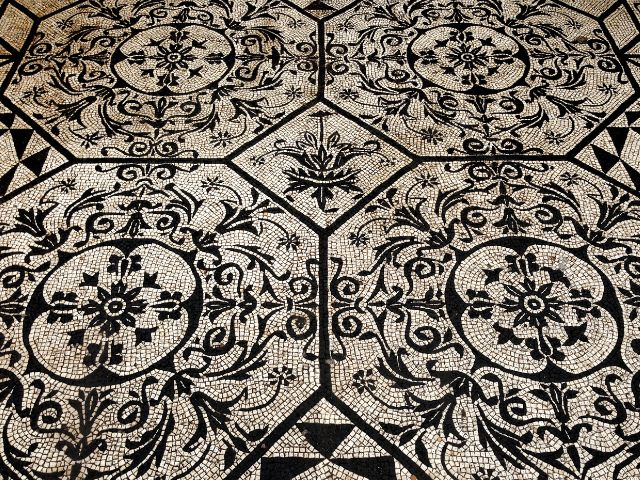 Hadrian's taste in interior style cannot be faulted - you'll find preserved and restored mosaics throughout Villa Adriana
Hadrian's taste in interior style cannot be faulted - you'll find preserved and restored mosaics throughout Villa AdrianaSome decorative elements were reused by Cardinal Ippolito d'Este to decorate Villa d'Este which I cover in the next section.
While a lot of what was once here is lost forever, much also survives, and you can for yourself when you visit.
Accessibility
Hadrian's Villa is a giant open-air archaeological site with modern paths and roads throughout.
These paths and roads are easily traversable for anyone, including those with accessibility challenges, and it is possible to see a large amount of the park this way.
Unfortunately, due to the nature of the ancient ruins, not all the areas within the site are accessible to visitors with mobility restrictions.
Before visiting, I'd recommend contacting Villa Adriana (yourself, or via your tour guide) to discuss any accessibility requirements in advance.
Planning your visit
Hadrian’s Villa covers a HUGE area (200 acres to be exact), making the whole site 130 times the size of the White House!
Many of the key areas to visit are spaced out, so be prepared to walk.
To see the main sites you should allow 3 hours minimum during your day trip from Rome.
If you want to see absolutely everything, you should plan to spend at least 6 hours here.
If you are visiting in the summer, be sure to bring a hat and sun block as the site is very exposed.
Consider also timing your visit for the early morning before the sun gets too hot.
If visiting at any other time of the year, bring a waterproof jacket and umbrella.
The weather in this area of Lazio can be variable and the site exposed to the elements.
Bring plenty of water and something to eat for lunch as on-site refreshment options are limited.
There is a small café/kiosk but the opening hours are inconsistent.
You'll find endless green spaces with benches where you can rest and recharge, as well as water fountains dotted around the park.
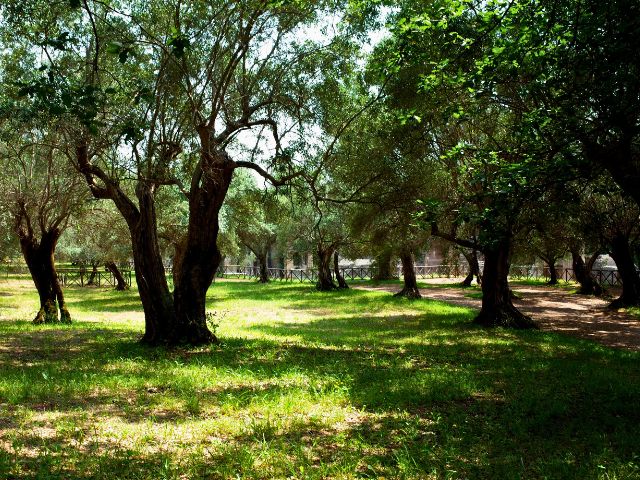 Consider bringing a picnic and finding a quiet spot to enjoy your surroundings - there are rumours that some of the olive trees here are nearly as old as the villa itself.
Consider bringing a picnic and finding a quiet spot to enjoy your surroundings - there are rumours that some of the olive trees here are nearly as old as the villa itself.Tickets and opening hours
Tickets can be purchased online or at the ticket office on site.
Booking in advance isn't generally required as it's such a large place, but it does allow you to skip the line if there is one.
For up to date opening hours and other information about visiting, check out the official website here.
Must-sees
Visitor welcome center
Before you start exploring, I recommended stepping into this little museum at the welcome center to view the to-scale model of the whole villa site.
Not only does it help orientate you, but it also shows the original grandeur and scale of Hadrian's Villa.
Canopus
This is maybe the most iconic feature of Hadrian's Villa.
The Canopus, a sanctuary of the god Serapis, was designed to replicate the river Nile in Egypt (hence the crocodile statues) which is where Hadrian's lover Antoninus died in a tragic accident.
This was Hadrian's personal and private space where he would come to remember his beloved.
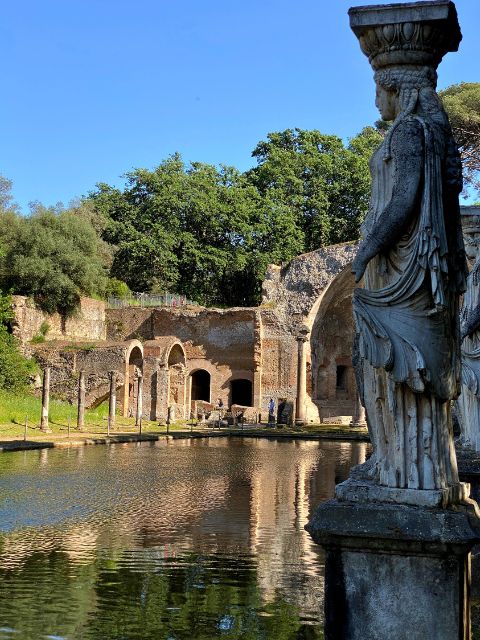 If you are planning on visiting the Vatican Museums while in Rome, be sure to search out the statues found here in their collection.
If you are planning on visiting the Vatican Museums while in Rome, be sure to search out the statues found here in their collection.Maritime theater / Teatro Marittimo
So called because of its circular shape and the presence of flowing water, this complex structure was another space Hadrian probably used as his private retreat.
The Maritime Theater, or Teatro Mirittimo, comprised over thirty rooms, all of which would have been intricately decorated.
Museum
Located next to the Canopus, this museum houses a lot of the original statuary that was found at the site which hasn't been relocated to other museums around the world.
I particularly like getting up close with the crocodiles!
When visiting on a hot day it provides a welcome break from the sun, and you'll also find bathrooms nearby.
Temple of Venus
While not much remains of this temple, its outlying location makes it worth visiting as it helps to put the size of the site into context.
I also find the location of the Temple of Venus on the edges of the park and the surrounding views evocative and peaceful.
The temple of Venus is a small circular temple with doric columns situated on the Temple Valley at Hadrian’s Villa.
It belongs to the latest building phase at the villa, between 133 and 138 CE.
The circular plan of the central structure, the use of the Doric order and the discovery of a fragmentary statue replica of the Aphrodite of Knidos led to the association between the Nymphaeum and the Greek tholos in Knidos, where the original statue by Praxiteles was located.
In the center of the round temple, a statue of the goddess stands.
This one is a cast. The original is in the museum on the site, the Antiquarium of the Canopus.
Visiting Villa d’Este in Tivoli
What is the Villa d'Este?
Welcome to the private villa and its beautiful gardens (and now resting place) of Cardinal Ippolito d'Este.
Cardinal d'Este, son of Lucrezia Borgia, began work in 1560, 11 years after he was appointed as governor of Tivoli in 1549, following an unsuccessful attempt to become pope.
He would go on to make five bids for the papacy, none of which were successful.
He had a Benedictine monastery destroyed to make way for his new villa.
Following his passion for antiquity, the cardinal removed a lot of the remaining statuary, ancient artworks and marble from Villa Adriana in order to construct and decorate his new home.
The primary construction took place over 9 years, during which time a lot of the terraced gardens, grottoes and fountains you see today were created.
Like Hadrian's Villa built centuries earlier, the cardinal's estate was residential.
But this one features hundreds of Baroque fountains, all gravity–powered. The Aniene River, frazzled into countless threads, weaves its way entertainingly through the villa. At the bottom of the garden, the exhausted little streams once again team up to make a sizable river.
The cardinal had a political falling-out with Rome and was exiled. With this watery wonderland on a cool hill with fine views, he made sure Romans would come to visit. It's symbolic of the luxury and secular interests of the cardinal.
In the subsequent centuries further elements were added by his descendants, and older parts renovated.
But for long periods the villa and gardens were abandoned.
After World War I the Italian state took control of the site and initiated a program of restoration, meaning this incredible place can be enjoyed today.
Accessibility
Villa d'Este features a vast open-air garden constructed on the side of a large hill.
Navigating the gardens is done via ramps and slopes, or stone staircases, which means they are not suitable for wheelchair users or those with limited mobility.
There is a golf cart route which allows people who would otherwise not be able to visit the gardens see some of the main features.
Take a look at the official site here for more details.
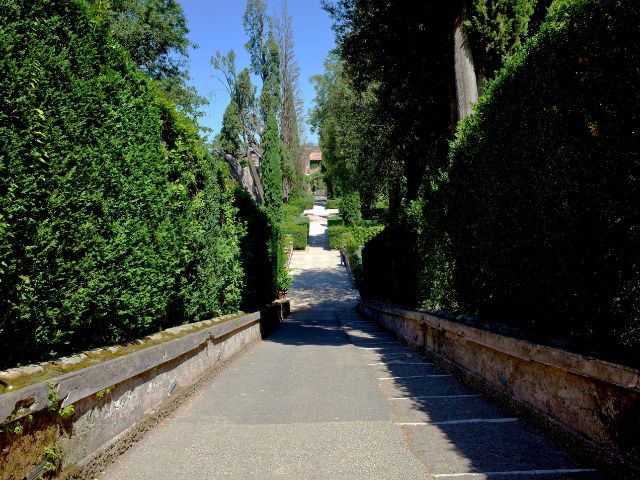 Some of the original stairs have been updated to feature ramps, but be aware that these are very steep in places.
Some of the original stairs have been updated to feature ramps, but be aware that these are very steep in places.Planning your visit
You should allow at a minimum two to three hours to fully explore the gardens and fountains.
Check the official site for Tivoli's villas for opening hours as they vary with the seasons.
The best time of day to visit Villa d'Este is in the afternoon.
This is especially good in the summer as the shade from the gardens and moisture from the fountains ensures the paths are lovely and cool.
Bring water and snacks as there are very limited food options on site.
The gardens are very central however so there are plenty of places nearby to have a coffee, gelato or lunch before or after your visit.
Tickets can be purchased online or at the entrance along with audio guides.
What to see in the villa
Villa d'Este is an enclosed site, meaning it's easy to navigate and see everything here if you follow the signs and recommended itinerary. My personal highlights of any visit include:
The villa
You'll enter the villa contrary to how Cardinal d'Este designed.
Originally visitors would come to the base of the gardens and slowly make their way up the hill to his home, demonstrating to them his power and wealth.
When you enter now, you first have the opportunity to explore the Cardinal's private residence where you'll find ornately decorated rooms.
The Fountain of the Organ
One of the fountains in the gardens is the Organ Fountain, the oldest example of a hydraulic organ.
Via a complex and delicate system, water and air is piped through a hidden network and used to create musical notes and sounds.
Over the course of its life it has been repaired and upgraded several times, with the most recent renovation being in 2003, meaning its magical sounds could be heard once again after a long period of silence.
The avenue of 100 fountains
This site is one of the most beautiful and unforgettable sites at Tivoli Gardens.
The hand-carved fountain heads are in multiple shapes designed to induce awe in the visitor - lilies, eagles, obelisks, and boats, grecian urns and animal heads.
Symbolically the lilies and eagles are from the coat of arms of the family of d'Este.
The water arrives in three channels and unites to form one symbolizing the joining of rivers to create the Tiber River. The avenue is shaded by trees creating an oasis of calm.
At the center a balcony overlooks the Fountain of the Dragons.
At the end of the avenue there is Rometta, a reproduction of the Tiberina island.
The Fountain of the Dragons
This fountain is located at the center of the gardens, a mystical masterpiece set in a semicircular recess between two steep semicircular staircases descending from the Avenue of 100 Fountains.
The four winged dragons are the symbol of the family of the reigning pope at the time, Gregory XIII, who visited d'Este at Tivoli.
The fountain is set in pools in the shape of shells and dolphins. Water spouts from each dragon as well as from a high jet of water in the center.
It is important to remember that the height of each water spout was determined by gravity and the size of the tubing in each fountain.
In back of the fountain is a niche containing a giant statue of Hercules, Tivoli's hero. Many member of the d'Este family took the name Hercules.
The steep staircases represent the difficulties faced by Hercules in his struggle between virtue and vice. The fountain represents the 11th effort of Hercules in killing the 100 headed dragon to recover the golden apples of the Garden of the Espiridi.
On the accompanying images, the statue of Hercules is difficult to appreciate as it is shaded throughout much of the day.
On the second image, note the palace in the distant background up the steep incline.
The Fountain of Neptune and Fish Ponds
This fountain is one of the more modern features of the garden, created in the 20th century to replace elements that had fallen into disrepair.
The fish ponds you can see here once served a practical purpose, providing the villas residents and staff with fish and other animals for food.
Finally, don't miss the newly restored Diana's Grotto, and the fine fountain of the Bicchierone by Bernini.
What else to see in Tivoli
If you find yourself with free time when in Tivoli, or are looking to explore further, considering visiting these sites and monuments.
These are just a selection of my favorites, as there is much more to be found:
Villa Gregoriana: Nature, History & a Hidden Waterfall
One of my favorite stops in Tivoli is Villa Gregoriana, a large park just a few minutes' walk from the town center. The first time I visited, I felt like I’d stumbled into another world—quiet wooded trails, crumbling ruins, mossy caves, and the roar of a massive waterfall echoing through the gorge.
The park was created in the 1800s when Pope Gregory XVI diverted the Aniene River to protect Tivoli from flooding.
The result? A dramatic waterfall that’s now the heart of this lush, romantic landscape. It's easy to see why painters like Poussin and Lorrain were so taken with it.
Today, it’s lovingly maintained by the Italian National Trust (FAI), and it’s the perfect place to slow down, breathe in some fresh air, and enjoy a walk that blends nature and history.
🕒 Opening Hours & Tickets
- Opening Hours: Daily from 10:00 AM to 6:30 PM (last entry at 5:30 PM)
- Tickets: Adults €10, children (6–18 years) €3, under 6 free
- You can purchase tickets online or at the entrance. If you're planning to visit other sites in Tivoli, consider the Villae Pass for combined entry to Villa Gregoriana, Villa d'Este, and Villa Adriana.
👟 Tips for Your Visit
- Footwear: Wear comfortable shoes with good grip—some paths can be a bit steep or uneven.
- Time: Give yourself 2–3 hours to really enjoy the walk and the views.
- Facilities: There are plenty of spots to rest and take in the scenery, but not many food options inside, so bring water and a snack if you think you'll need it.
Temple of Vesta /Temple of the Sybil
Perched dramatically on the cliff above Villa Gregoriana, the Temple of Vesta is one of Tivoli’s most iconic sights. You can spot its round columns and stunning position from several viewpoints inside the park—but it’s even more impressive up close.
When I first stood there, looking out over the waterfalls and the lush valley below, it was easy to see why this spot was chosen for an ancient temple.
Built in the late Roman Republic, the temple may have originally been dedicated to Hercules, despite often being linked to the goddess Vesta or the Sibyl of Tibur.
Its elegant Corinthian columns and striking location have inspired countless artists and architects—especially during the 18th and 19th centuries when it became a favorite subject of romantic painters.
Whether you’re into history, architecture, or just jaw-dropping views, this little temple is well worth the short climb.
- Sanctuary of Hercules Victor, a vast ancient Roman temple complex dedicated to Hercules with a theatre built in to the slope of the hills.
- Rocca Pia - this imposing castle in the centre of Tivoli was built by pope Pius II in 1461 to control the local area.
If you are visiting with a tour guide or private guide that provides transport from Rome, be sure to ask them to ask them to take you past the ruined ancient aqueducts on the outskirts of Tivoli.
Where to eat and drink in Tivoli
For me, there is one place which is a must-visit for food and drinks in Tivoli; Ristorante Sibilla.
Perfect for a traditional Italian lunch and/or dinner and located only 10 minutes walk from Tivoli's main square (Piazza Garibaldi), this restaurant is renowned for its high quality, seasonal menu.
It has been the choice dining location for many of history's most famous figures, including Neil Armstrong, Yoko Ono and Princess Margaret of Great Britain.
When you arrive you'll see what else also makes this restaurant special; from its outdoor terrace you can marvel up-close at the ancient ruins of the Temple of Vesta and Temple of the Sybil.
If that wasn't enough, looking the other way you'll be treated to incredible views of Tivoli's famous waterfalls and a special view of this beautiful town.
If you are on a guided tour of Tivoli and don't have time to visit Ristorante Sibilla, I'd recommend making a separate day trip from Rome to Tivoli just to eat here and take in the views!
Romewise's Top Travel Resources
Ready to book your trip to Rome? Take a look at these helpful links to companies we use and trust:
- Keep your travel spending simple with the Wise card, which removes all the worry about exchange rates and high transaction fees all over the world
- Search for and book your perfect accommodation
- Our complete guide to what to pack for Rome
- The number one travel accessory, a multi-point travel adapter and voltage converter
- Browse a huge range of tours in Rome and beyond
- Experience unique tours and special access to Rome's most popular sights
- Protect yourself with comprehensive travel insurance
Within this post there are some affiliate links for products and services. For more details about our affiliate policy click here.
Get your 100% free Rome trip planner now!
Simply sign-up today for our free newsletter and get the Romewise Quick Start guide to Rome:
We are committed to respecting your data. Click for our Privacy Policy.
Comments? Questions? Suggestions?
Please come over to the private Romewise Facebook group and join in the conversation.
You will often find me there, happy to answer your questions / comments!
You will also meet other Rome lovers and experts, too.
What are you waiting for?
- Romewise Home Page
- What to Do in Rome
- Romantic Things to Do in Rome
- Tivoli Day Trip

